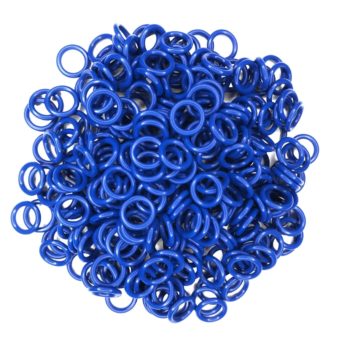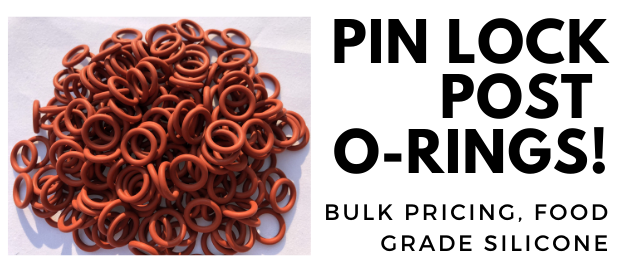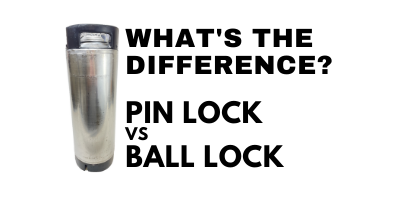
Pin Lock Post O-Rings, Bulk Quantities on Sale
 PIN LOCK Post O-Rings!
PIN LOCK Post O-Rings!
Pin Lock users are regularly left out when it comes to parts and accessories. Point in case… I am aware of very few offerings for pin lock post o-rings (0 offerings in bulk). Most shops sell the same o-ring for both ball and pin lock posts. Pin lock post o-rings are larger than ball lock post o-rings.
From Valuebrew:
“Pin Lockers Rejoice! We’re excited to announce we have sourced Pin Lock Post O-Rings made from FDA Silicone! You can finally buy Pin Lock specific o-rings in food safe materials… in bulk quantities.”
- All count options are on sale. Prices range from $4.99 to $10.99 depending on quantity
- As of this posting they are running a shipping special. Your choice of 2 or 3 packs ship for the same shipping cost as a single pack.
- Applies to 10 and 25 count options.
- Mix and match – Choose from – ball or pin lock post, dip tube, internal QD and universal poppet
- Valid for US addresses.
- Check site for current selection, price and availability.
New! Keg Post O-Rings for PIN LOCK Kegs – Food Safe Silicone
Food Safe Keg O-Rings – 3 for 1 Shipping Selection
Color Coded Options:
 Valuebrew has recently released color coded options in blue and green. These are sized for ball lock kegs. For pin lock keg owners, Valuebrew suggests using your choice of color on the liquid post and pin lock size o-rings on your gas post. The logic behind this is beer is less likely to leak and if it does… you’ll see it. Where gas would be invisible and is more likely to leak.
Valuebrew has recently released color coded options in blue and green. These are sized for ball lock kegs. For pin lock keg owners, Valuebrew suggests using your choice of color on the liquid post and pin lock size o-rings on your gas post. The logic behind this is beer is less likely to leak and if it does… you’ll see it. Where gas would be invisible and is more likely to leak.
More about food safe materials:
For whatever reason, it’s difficult to find food safe keg o-rings. Maybe some of the o-rings that are available are food safe, but very few are actually labeled as such.
The fact is we’re putting beer (food) in our kegs and we should be using food safe materials whenever we can. More Info: Food Safe Replacement Keg O-Rings
Related:
Also: Kegerator Tips & Gear | Keg Repair Part #s | Recent Keg Finds
Our Top Draft Resources!
Check our our Top Draft Related Resources- Commentary: Pin Lock Keg Pricing and Availability
- Check Your CO2 Regulator for Leaks!
- How to get a keg ready for first use? New Keg Cleaning and Prep
- Portable Draft Beer Serving Options!
- Pin Lock Keg Pricing and Availability
- The Most Difficult Spot to Check for CO2 Leaks
- Keg O-Ring Materials Selection! – EPDM, Silicone and Buna-N?
- Why Do I Have Bubbles in My Beer Line? Diagnosing and Fixing Kegerator Foam Problems
- Five Benefits of Using Corny Kegs As Fermenters
- Rebuilding & Reconditioning Homebrew Kegs!
- Food Safe Replacement Keg O-Rings in Bulk
- Hands on Review: Kegland DuoTight Fittings & EVABarrier Tubing!
- Why Won’t My Beer Carbonate? Fixing Draft Beer Carbonation Problems
- What Does a Flow Control Faucet Do?
- Upgrade Your Kegerator – 6 Improvements!
- Serve Homebrew on Any Kegerator & Convert Commercial Kegerator to Homebrew
- Tips and Gear for Growler Filling
- What’s the Difference Between Ball Lock Kegs and Pin Lock Kegs?
- Checking for Draft System CO2 Leaks – Using The Pressure Gauge Method
- Tip: Consider Oetiker Stepless Clamps for Kegerator Gas and Beer Lines
- Hands On Review: Inkbird ITC-308 Dual Stage Temperature Controller +WiFi Version
- Universal Poppets Tips and Tricks!
- Convert Your Mark II Keg & Carboy Washer to a Recirculating Draft Line Cleaning Pump!
- Step by Step: Finding and Fixing Keg CO2 Leaks
- Kegerator Temperature Probe Placement – To Immerse or Not To Immerse? – three tests to determine optimal pla…
- Kegerator Beer Line Temperatures & Reducing Foam with a Recirculating Fan
- Kegging CO2 Use Estimations and Calculations
- Balancing Your Kegerator Draft System
- Building a Simple Ball Lock Draft Line Flushing Setup
- Build a Recirculating Draft Line Cleaning Pump
- Home Brew Keg Roundup – New & Used, 5 and 2.5 Gallon & More!
- Damp Kegerator? Fix Kegerator Condensation
- Homebrew Temp Controller Roundup! – Kegerator and Fermentation – concepts, applications and models
- Bulk Keg Orings and Keg Parts Reference
This post may contain affiliate links. We may make a commission when you use our links. This will never cost you extra. Thank you for supporting Homebrew Finds!
greatdealsMake sure the components you use are compatible and rated for your intended application. Contact manufacturer with questions about suitability or a specific application. Always read and follow manufacturer directions.

